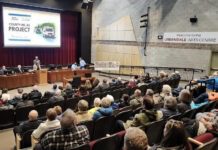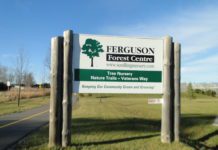The announcement, when it came, was like a bolt from the blue, bringing shock and dismay to the residents of North Grenville. Of course, North Grenville didn’t yet exist, for this was October, 1995, and the Ontario Government had released their first targets for closures and cuts under the Mike Harris “Common Sense Revolution”. The G. Howard Ferguson Forest Station, covering 1,100 acres in Oxford on Rideau Township, was scheduled for closure by June of the next year.
The Forest Centre had been opened in 1945, to establish both a mixed forest for lumber and other specialist work, and, most importantly, a tree seedling nursery to produce stock for reforestation efforts in Eastern Ontario. It had been found that much of the land in the region was susceptible to devastating loss of top soil once trees were removed by farmers. Areas such as the one now covered by Limerick Forest, soon became unable to sustain farms and settlement. Other places actually became sandy deserts, as the tree cover was removed. The role of the Forest Station in Kemptville was vital in reforestation, because, as one expert put it: “Indigenous species must be grown in the proper time zone and soil conditions. Seedlings from other areas are not satisfactory and do not grow well. The difference from one area to another is highly significant.”
In addition, the closure of the Ferguson Station would mean loss of jobs and a precious asset to the Oxford-on-Rideau Township area. It all seemed so unnecessary. Why shut down such a valuable resource? The Ministry of Natural Resources [MNR], which operated the Station, pointed to the one million dollars they lost every year at the Station. There were serious questions in the community about the efficiency of MNR operations, however. The Government were charging 10¢ per tree to buyers, when it was calculated that the market would easily pay three times that amount.
The community mobilised and a Community Consortium was formed, but meetings with the Minister in charge, and correspondence with the Premier’s office seemed to produce no response; the Province seemed determined to push through with the closure of the Station. Only strong representations from MPP’s and Don Cameron’s Oxford Council delayed the removal of equipment from the Station. The MNR’s plan was to sell off all the two- and three-year old trees and plough the rest of the twelve million seedlings into the ground. As it takes three years for seedlings to become available for harvesting, this would leave any potential buyer of the Station with no crop for three years after purchase. Clearly, the Province was not interested in maintaining the Station as a tree nursery, regardless of the essential role it played in reforestation of eastern Ontario.
Once again, the community mobilised. Urgent representations were being made to Oxford-on-Rideau politicians, and, in March, 1996, Don Cameron wrote to the MNR about buying the Station at a minimal cost. The Station closed, as planned, in June, 1996, and the MNR started the process of selling the property. Volunteers in the community were asked by Council to come to the Station and weed and irrigate the three million seedlings in order to save the crop for at least another year.
The Province now had to dispose of the property, and under Ontario law, the right of first refusal went to the Oxford Township. In July, MNR asked Oxford if they were interested. Oxford Reeve, Don Cameron and Councillor Owen Fitz’gerald argued in favour of Oxford expressing an interest in the purchase and Council agreed unanimously with this approach.
There was some thought among Council members that some of the land could then be sold to developers for housing; but it seems Don and Owen argued that the land in question may have been on a flood plain and could not be built on. They may, or may not, have known that this wasn’t the case. In any event, the idea was dropped. Don then informed MNR of Council’s decision and added a very significant statement. Oxford would not be changing the zoning on the land, no matter who bought it. It would remain agricultural land. This would obviously make the property harder to dispose of and limit MNR’s choices in the matter. This stand may well have saved the Station.
Weeding and irrigation continued to be provided by volunteers. Local people came to help, as did people from Ottawa and surrounding areas. Buses of Mohawks arrived from Akwesasne to help in the work, and the extent of the voluntary effort must have come as a great source of encouragement to those working to save the Station. Ontario now decided it only wanted to sell about 360 acres of the Station, the part that was cultivated.
Ontario was asking Oxford Township to pay $1.2 million for the 360 acre package (including equipment, buildings and crops). The Township made an offer of $525,000 for the land, buildings, equipment and crops, and repeated the veiled threat that the land would never be rezoned by the township.
By August, 1997, an agreement was reached between Oxford Township and the MNR, and the Township set up an Advisory Board, a group of volunteers who would oversee the newly-acquired Station and try and build a solid economic foundation for future growth. Previous customers of the Forest Station committed to buying trees from the new facility and by January, 1998, half a million trees had already been sold, about half of the available stock for that year. It would take a long time to get things on a secure footing. But as the headline said in March, 1998: the “Forest Station was Back in Business Again”.






